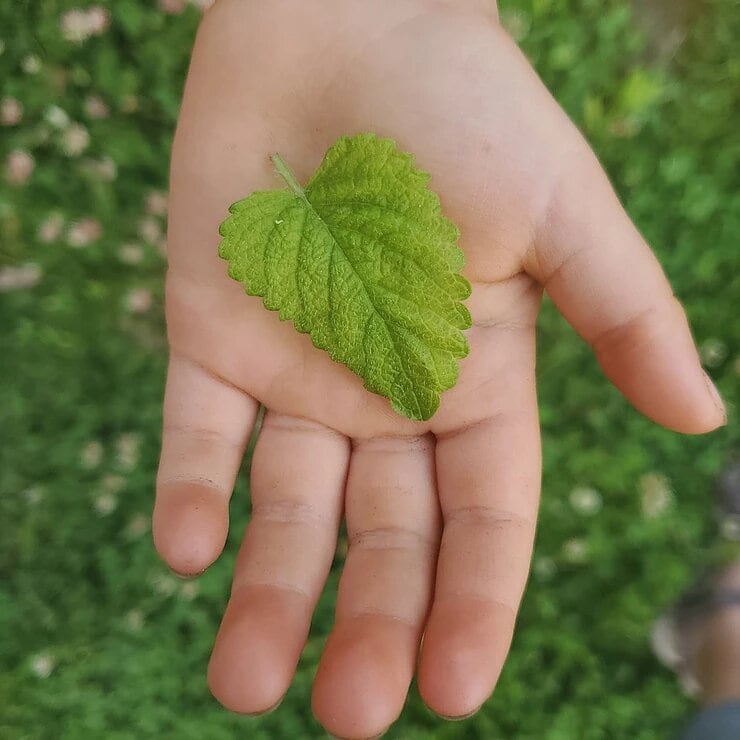Learn to Speak the Language of Plants

The other day I gave my daughter lemon balm. She loves taking herbs, and I’d been thinking for a while that this would be a good fit for her. Calming her nervous system, relaxing the tension she holds in her gut, and generally being uplifting for the four-year old angst she’s currently caught up in.
One drop on her tongue, and her whole demeanor changed. She took a deep breath, and got a little taller. Holding her hand over her heart, she said “Mama, I feel the movement! It makes my heart bigger, and bigger, and bigger, and that makes me happier and happier and gives me more energy.” Followed by the simple statement of “yummy.”
Truth.
I was honestly bowled over. I’ve studied plants for longer than my daughter has been alive, and here she was, intuitively experiencing and expressing the actions of lemon balm. I’ve never actually told her anything about this particular plant, but the ability of its heart shaped leaves to uplift us has been known to herbalists for centuries. And while it’s not known for giving us more energy, it certainly can do this for us by liberating energy that is currently bound up in patterns of tension and stress.
And while I was surprised, part of me understood that this was absolutely normal. That we are born with the gift of being able to intuit how a plant is affecting us. Much like the quote by Picasso about all children being born artists, the problem is how to keep this gift alive as we get older.
So how can we cultivate our intuitive understanding of plant medicine? How can we tap into this unfiltered experience that my daughter had with lemon balm, every time we interact with a plant?
To be totally transparent, this is something I’m still cultivating myself. I’m certainly no whiz at immediately tuning into this state of receptivity, and I’m the first one to admit that my thinking brain gets in the way. These are a few of the practices that I’m using to get closer to being able to hear the language of the plants.
1. Tune into your heart
Perhaps it’s no accident that my daughter’s first reaction to lemon balm was to notice a movement in her heart. As recognized famously by Stephen Harrod Buhner, the heart is an organ of perception. He certainly didn’t come up with this idea, though. In Traditional Chinese Medicine, the heart is recognized as the seat of thought and mental activity (instead of the brain). I have found immense understanding can come when I take the elevator down from my brain into my heart, and really feel into that part of my body. Every time I start to have a thought that intrudes with a latin name or some learned action of a plant, I let it pass and then return to the heart.
2. Become aware of the rest of your body
For me, once I tune into my heart, it becomes easier to tune into the rest of my body. We are so accustomed to turning off perception of bodily sensations. We live in our heads most of the time, often out of necessity (so we can be more productive) or out of a desire for protection (it doesn’t always feel safe for people to be in their bodies) However, as my daughter demonstrated, her knowledge of lemon balm didn’t come from thinking about the plant, but rather a felt experience in her body. This is how plants speak to us — not by some strange voice that will tell us in plain English what’s up, but rather in the language of sensation. How does your breathing change when you interact with the plant? Does it make you want to stretch?
3. Work with the plant frequently
While immediate insight can sometimes come by consuming or sitting with a plant, not all plants give up their secrets so easily. Like people, it takes time to get to know them. Your experience of ashwagandha or cannabis is likely to be very different after working with them for two months, as opposed to working with them just once. As in any thing, any lasting shift in habit, perception, or health requires daily, committed action. This is where the deeper wisdom will arise.
This is a practice, arguably a spiritual practice. One that at one time was essential for human survival. And arguably still is. Learning to speak the language of plants is a lifelong pursuit filled with practices such as those above, and also requires a lot of unlearning. Unlearning to identify so strongly with our brains. Unlearning the belief that we are somehow separate and superior from the creatures that surround (and inhabit) us. Unlearning that the only legitimate knowledge comes from books and years of study in accredited institution.
Where are you along this journey? What plants call out to you? What things do you do to cultivate communication with them?
Recent Posts
Join Our Mailing List!
Like what you see on our blog? Get on our mailing list to receive updates!



